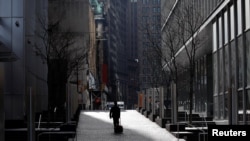Federal Reserve Board Chairman Jerome Powell says that the hundreds of thousands of business owners who have shut their doors as a part of the nationwide effort to slow the spread of the novel coronavirus are doing a public service, and that the central bank and other government agencies will do their best to help them recover from the economic damage that results.
In an interview Thursday on NBC's Today Show, Powell said that the economy "may well" be in a recession already, but stressed that the underlying circumstances are vastly different from previous economic slowdowns. The interview took place on a day when it was reported that 3.3 million Americans had filed for unemployment compensation in the previous week — nearly five times the previous high set in 1982.
"This is a unique situation — it's not like a typical downturn," he said. "We've asked people to step back from economic activity really to make an investment in our public health. They're doing that for the public good."
As part of a government-wide effort, he said, the Fed is taking extraordinary steps to make sure that credit is available to businesses and individuals that need it in order to get through the shutdown without facing financial ruin.
Speaking directly to Americans hit hard by the sudden suspension of economic activity, Powell added, "The Federal Reserve is working hard to support you now, and our policies will be very important, when the recovery does come, to make that recovery as strong as possible."
Fed can't do it alone
The Federal Reserve cannot save the American economy from the effects of a lengthy coronavirus shutdown all by itself, but it has a major role to play in limiting the damage a months-long shutdown will cause, and creating the opportunity for businesses to rebound once the crisis has passed.
Actions by the central bank are just part of a broader federal response, much of it laid out in a $2 trillion rescue package that was expected to receive congressional approval by the weekend. The package includes direct payments to individuals, financial support for struggling businesses, and an infusion of aid to states, whose budgets are being taxed by the costs of mounting a response to a global pandemic. The Treasury Department is also extending the deadline for 2019 income tax payments to July, effectively providing an interest-free loan to millions of Americans.
Unlike the cash stimulus coming from Congress, which is meant to provide immediate relief and to spur demand, the Fed's biggest mission is to make it possible for businesses and individuals to weather a lengthy shutdown with enough vitality left to start back up again once it is safe to do so.
"We're trying to create a bridge from our very strong economy to another place of economic strength, and that's what our lending really does," Powell said.
$4.5 trillion in lending
The economic stimulus approved unanimously by the Senate and the House of Representatives includes a provision directing the Treasury Department to provide the Fed with a $454 billion "backstop" to support a lending program.
The money will effectively serve as a massive loan guarantee fund that the central bank can leverage tenfold to extend credit to banks that make loans to individuals and to businesses —including the small operations being hit hardest by the crisis. Powell said that for every dollar in loan guarantees, the Fed can extend about 10 dollars in credit, meaning that the legislation could support an unprecedented $4.5 trillion in credit.
At the same time, the Fed and its fellow financial services regulators urged the institutions they supervise to make use of the unprecedented amount of funding available.
In a joint release from the Fed, the Comptroller of the Currency, the Federal Deposit Insurance Corporation, the National Credit Union Administration, and the Consumer Financial Protection Bureau, regulators said they "specifically encourage financial institutions to offer responsible small-dollar loans to both consumers and small businesses. The agencies recognize the important role that responsibly offered small-dollar loans can play in helping customers meet their needs for credit due to temporary cash-flow imbalances, unexpected expenses, or income short-falls during periods of economic stress or disaster recoveries."
Flexibility in repayment
Going further, regulators asked lenders to make extra efforts to work with borrowers who have trouble repaying those loans. "For borrowers who experience unexpected circumstances and cannot repay a loan as structured, financial institutions are encouraged to consider workout strategies designed to help enable the borrower to repay the principal of the loan while mitigating the need to re-borrow."
Over the past few weeks, the central bank had taken multiple actions to keep credit flowing through the economy. On March 15, the Fed slashed its benchmark interest rates to zero and announced a program to buy as much as $700 billion in Treasury- and mortgage-backed securities, another step meant to keep rates low. In addition, the bank loosened credit requirements for banks that borrow directly from it, and eased regulatory restrictions that require banks to keep significant cash reserves.










